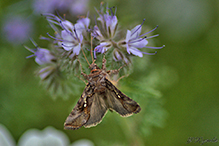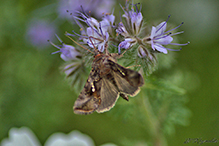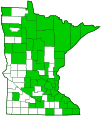Common looper
(Autographa precationis)
Conservation • Description • Habitat • Ecology • Distribution • Taxonomy
| Hodges # | 8908 |
||
Conservation Status |
|||
| IUCN Red List | not listed |
||
| NatureServe | N5 - Secure SNR - Unranked |
||
| Minnesota | not listed |
||
Description
Common looper is a widespread, medium sized moth. It occurs in the United States and southern Canada east of the Great Plains, and there are a few scattered records west to the Rocky Mountains. It does not occur in the deep south.
Common looper is found in a variety of habitats. One author lists only open habitats, including “fields, gardens, agricultural fields, waste places, and other open and early successional habitats.” Another author states that in North Carolina, “While we have some records from open habitats in the Piedmont, the majority of our records come from forested sites in the Mountains.”
Adults are active in Minnesota from May to October. The larvae are hosted by many low-growing herbaceous plants, including alfalfa, burdock, clover, common lambsquarters, dandelion, plantain, sunflower, vervain, and wild parsnip. They are an occasionally pest of garden plants, including cabbage and lettuce.
Adults are 11⁄16″ to ¾″ (18 to 20 mm) in length and have a 1 3⁄16″ to 1½″ (30 to 38 mm) wingspan. That is medium sized for a moth but fairly large for a looper moth (subfamily Plusiinae). Moth size is sometimes given in terms of forewing length, which in this case is 9⁄16″ to 11⁄16″ (14 to 18 mm).
The antennae on both sexes are thread-like. The collar is thin and reddish. A loose tuft of hair-like scales forms a tall crest on the thorax, and there is a similar but smaller tuft on the abdomen.
The background color of the forewings is gray but extensive dark reddish-brown mottling and poorly defined markings make the wings mostly dark. The stigma is silvery white, and it consists of two parts, an inner open loop, and an outer solid spot. The two spots are sometimes separated, but they are usually fused, comma shaped, partially separated by a broad inverted v-shaped area. The kidney-shaped spot in the lower median area (reniform spot) is surrounded by a thin white line that is often obscure. A shiny brassy area below the stigma and reniform spot extends to the inner margin.
The caterpillar is up to 1⅜″ (3.5 cm) long, green, and covered with minute spines (spinules). It appears scalloped when viewed from the side. The breathing pores (spiracles) are white. The line above the spiracles (spiracular line) is black above and white below, and it fades out after the sixth abdominal segment (A6). There is usually a shiny black spot above each spiracle on A1 through A4 or A6. The head is green with a black bar on each side.
Size
Total length: 11⁄16″ to ¾″ (18 to 20 mm)
Forewing length: 9⁄16″ to 11⁄16″ (14 to 18 mm)
Wingspan: 1 3⁄16″ to 1½″ (30 to 38 mm)
Similar Species
Habitat
Open and forested habitats
Ecology
Season
Three or more generations per year: May to October
Behavior
Life Cycle
Larva Food/Hosts
Many low-growing herbaceous plants, including alfalfa, burdock, cabbage, clover, common lambsquarters, dandelion, lettuce, plantain, sunflower, vervain, and wild parsnip
Adult Food
Distribution |
||
|
Sources 21, 24, 29, 30, 71, 75, 82, 83. Biodiversity occurrence data published by: Minnesota Biodiversity Atlas (accessed through the Minnesota Biodiversity Atlas Portal, bellatlas.umn.edu, 10/15/2025). Lafontaine, J. D. and R. W. Poole. 1991. Noctuoidea, Noctuidae (Part), Plusiinae. In R. B. Dominick et al. (eds.). The moths of America North of Mexico. Fascicle 25.1. The Wedge Entomological Research Foundation. Washington, D. C. 182 pp. |
|
| 10/15/2025 | ||
Occurrence |
||
Common |
||
Taxonomy
Order
Lepidoptera (Butterflies and Moths)
Superfamily
Noctuoidea (owlet moths and allies)
Family
Noctuidae (cutworm moths and allies)
Subfamily
Plusiinae (looper moths)
Tribe
Plusiini
Subtribe
Plusiina
Genus
Autographa
Subordinate Taxa
Synonyms
Autographa tana
Phytometra precationis ab. tana
Plusia precationis
Common Names
common looper
Glossary
Reniform spot
A kidney-shaped spot or outline in the lower median area near the PM line on the forewing of many moths.
Spiracle
A small opening on the surface of an insect or arachnid through which it breathes.
Stigma
In plants, the portion of the female part of the flower that is receptive to pollen. In Lepidoptera, an area of specialized scent scales on the forewing of some skippers, hairstreaks, and moths. In other insects, a thickened, dark, or opaque cell on the leading edge of the wing.
Visitor Photos
Share your photo of this insect.
This button not working for you?
Simply email us at info@MinnesotaSeasons.com.
Attach one or more photos and, if you like, a caption.
Bill Reynolds |
||
I believe this is a Common Looper Moth. It was nectaring on Lacy Phacelia. |
||
 |
 |
|
MinnesotaSeasons.com Photos
|

Slideshows
Common Looper Moth - Hodges#8908 (Autographa precationis)
Andrée Reno Sanborn

Visitor Videos
Share your video of this insect.
This button not working for you?
Simply email us at info@MinnesotaSeasons.com.
Attach a video, a YouTube link, or a cloud storage link.
Other Videos
Common Looper Moth (Noctuidae: Autographa precationis) Lateral view
Carl Barrentine
Common Looper Moth in Action
edweirdk

Visitor Sightings
Report a sighting of this insect.
This button not working for you?
Simply email us at info@MinnesotaSeasons.com.
Be sure to include a location.
MinnesotaSeasons.com Sightings


